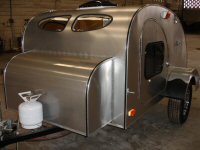Last month while driving to my annual squirrel hunt/general BS/music get-together in the Shawnee NF near Wolf Lake, IL, I drove/towed thru 3 severe T'Storms, several miles with at least a couple of inches of water standing on the highway. When I arrived at camp I discovered that my bedding was wet on each side & at the front corners of the mattress. At first I thought it was coming in at the front of the TD but I have a small 'vault' built into the front of the cabin to store my hunting rifles & a quick check of that area revealed no moisture at all in there. Finally traced the water to entry point around the wheel wells (the TD tows very slightly 'nose down' so the water had migrated forward to wet the sides & front corners.
Dried everything out & when I returned home I jacked up the trailer, lowered the stabilizer jacks & 'pulled' the wheels. Upon close inspection I thought I could see some slight separation at one of the 'seams' where I'd built up the wheel wells during initial construction (I'd coated the entire underside of the floor with the 'black, gooey stuff' & it appeared mostly intact & without much damage from road travel, trash, & such. I took out the mattress & it was immediately apparent where the water was coming in
 . There was at least a 3/32" & in places 1/8" gap alongside the wheel well on driver side & a slightly smaller 'crack' on the passenger side where I could plainly see 'daylight through' to the underside. I'd sealed all ply edges/joints with CPES during construction but apparently when I was 'rear-ended' Labor Day weekend of 2010 the impact had caused some separation (or perhaps accelerated an already existing separation) of the joint/seam at the wheel wells.
. There was at least a 3/32" & in places 1/8" gap alongside the wheel well on driver side & a slightly smaller 'crack' on the passenger side where I could plainly see 'daylight through' to the underside. I'd sealed all ply edges/joints with CPES during construction but apparently when I was 'rear-ended' Labor Day weekend of 2010 the impact had caused some separation (or perhaps accelerated an already existing separation) of the joint/seam at the wheel wells.
Because of the way I'd constructed the floor/wheel wells I saw no way to 'pull' the wood together to close the gap so I filled it with 'siliconized acrylic latex' caulk from the top, covered my hubs with plastic bags & used an entire spray can of automotive undercoating to give both wheel wells (& surrounding area) several layers of undercoating.
After letting the entire thing 'cure' for 24 hours or so I 'sprayed' the underside with water from the garden hose using considerable pressure. No water came inside so I'm calling it fixed at least for the moment. I'll keep a close watch on it for any additional leaks or separation problems.
I chose the acrylic latex caulk for its 'elasticity' even after curing, in case of 'movement' at the wheel well area, & the multiple coats of the 'rubberized' undercoating should prevent any entry from the bottom
 .
.
The problem -
The fix(?)

